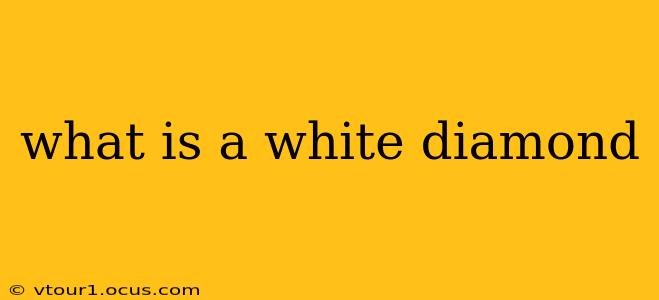A white diamond, often simply called a diamond, is a gemstone renowned for its exceptional brilliance, fire, and scintillation. But what truly defines a white diamond, and what separates it from other colored diamonds or gemstones? Let's delve into the specifics.
What Makes a Diamond White?
The whiteness, or more accurately, the colorlessness of a white diamond, stems from its chemical composition and crystal structure. Diamonds are composed entirely of carbon atoms arranged in a specific crystalline lattice. The absence of other elements or impurities within this structure is what leads to the prized colorless appearance. However, even the purest diamonds can exhibit subtle tints, influencing their grading and value.
How are White Diamonds Graded?
The color of a white diamond is a critical factor in its grading and, consequently, its price. Gemological institutes, like the Gemological Institute of America (GIA), use a grading scale to assess the diamond's color, typically ranging from D (colorless) to Z (light yellow or brown). Diamonds graded D-F are considered colorless, while those graded G-J are near-colorless. Diamonds with grades beyond J exhibit a more noticeable color. This grading system is crucial in determining the value and desirability of a white diamond.
What are the Different Types of White Diamonds?
While the term "white diamond" encompasses a spectrum of color, several classifications exist based on other characteristics:
- Type Ia diamonds: These contain nitrogen impurities, often causing slight yellow or brown tints. They are the most common type.
- Type Ib diamonds: These contain isolated nitrogen atoms, resulting in a more noticeable yellow hue. They are less common than Type Ia.
- Type IIa diamonds: These are extremely rare and contain very few impurities, resulting in exceptional clarity and colorlessness. They often command the highest prices.
- Type IIb diamonds: These are also rare and contain boron impurities, giving them a blue color instead of white.
What is the Difference Between a White Diamond and a Clear Diamond?
The terms "white diamond" and "clear diamond" are often used interchangeably, but there's a subtle distinction. A "clear" diamond implies the absence of inclusions (internal flaws) and blemishes (external imperfections), while a "white" diamond primarily refers to its color. A diamond can be clear but still possess a slight tint, while a white diamond might contain minor inclusions, but still exhibits desirable colorlessness.
How Much Does a White Diamond Cost?
The cost of a white diamond is hugely variable and depends on the "4Cs": carat, cut, clarity, and color. A larger carat weight, an excellent cut that maximizes brilliance, high clarity (few to no inclusions), and a colorless grade (D-F) will all significantly increase the price. Factors like fluorescence (the diamond's reaction to ultraviolet light) can also affect the price. It's impossible to give a definitive price without knowing the specific characteristics of the diamond.
How Can I Tell if a Diamond is Real?
Determining the authenticity of a diamond requires expertise. While certain tests can be performed at home (like checking for scratches or observing the diamond's reflection), professional gemological testing is recommended for reliable confirmation.
Where Can I Buy a White Diamond?
White diamonds are available from numerous jewelers, both online and in physical stores. It is crucial to buy from reputable sources that provide certification from a trusted gemological institute, like the GIA or AGS, to ensure authenticity and quality.
By understanding these factors, you can navigate the world of white diamonds with confidence and appreciate the nuances that contribute to their unique beauty and value.
